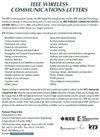基于 GNN 的数字孪生增强型多无人机雷达网络资源分配
IF 4.6
3区 计算机科学
Q1 COMPUTER SCIENCE, INFORMATION SYSTEMS
引用次数: 0
摘要
相互干扰一直是多无人机(multi-UAV)网络中的一个关键问题。作为一种先进技术,数字孪生(DT)可将物理实体映射到虚拟域中,实现实时监控和动态更新,从而提高多无人机网络的适应性和性能。在这封信中,我们研究了多无人机雷达传感网络的联合频谱分配和功率控制,在这种网络中,多个无人机(UAV)同时分别执行雷达传感,以探测目标并避免碰撞。通过将多无人飞行器网络建模为图,我们采用图神经网络(GNN)来捕捉环境特征、构建 DT 网络并解决资源分配问题。特别是,我们提出了一种基于消息传递神经网络的频谱分配方法和一种基于图注意网络的功率控制方法,以最大化所有无人机之间的最小雷达回波信噪比(SINR)。仿真结果表明,所提出的基于 DT 增强 GNN 的资源分配方法可以显著提高最小 SINR 并扩大感知覆盖范围。本文章由计算机程序翻译,如有差异,请以英文原文为准。
GNN-Based Resource Allocation for Digital Twin-Enhanced Multi-UAV Radar Networks
Mutual interference has been a critical issue in multiple unmanned aerial vehicles (multi-UAV) networks. As an advanced technology, digital twin (DT) maps physical entities into virtual domain, enables real-time monitoring and dynamic updates, thereby enhancing the adaptability and performance of multi-UAV networks. In this letter, we investigate joint spectrum allocation and power control for a multi-UAV radar sensing network, where multiple unmanned aerial vehicles (UAVs) simultaneously perform radar sensing separately to detect targets and avoid collision. By modeling the multi-UAV network as a graph, we employ graph neural network (GNN) to capture environmental features, construct the DT network, and address resource allocation issues. In particular, we propose a message-passing neural network based spectrum allocation method and a graph attention network based power control method to maximizing the minimum radar echo signal-to-interference-plus-noise ratio (SINR) among all UAVs. Simulation results show that the proposed DT-enhanced GNN based resource allocation method can significantly improve the minimum SINR and extend the sensing coverage.
求助全文
通过发布文献求助,成功后即可免费获取论文全文。
去求助
来源期刊

IEEE Wireless Communications Letters
Engineering-Electrical and Electronic Engineering
CiteScore
12.30
自引率
6.30%
发文量
481
期刊介绍:
IEEE Wireless Communications Letters publishes short papers in a rapid publication cycle on advances in the state-of-the-art of wireless communications. Both theoretical contributions (including new techniques, concepts, and analyses) and practical contributions (including system experiments and prototypes, and new applications) are encouraged. This journal focuses on the physical layer and the link layer of wireless communication systems.
 求助内容:
求助内容: 应助结果提醒方式:
应助结果提醒方式:


